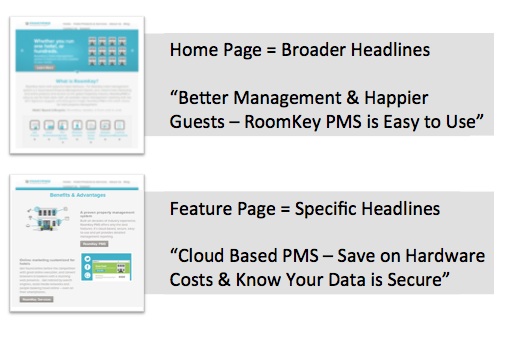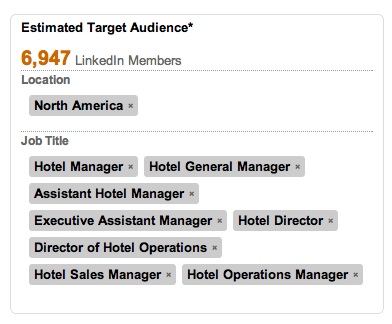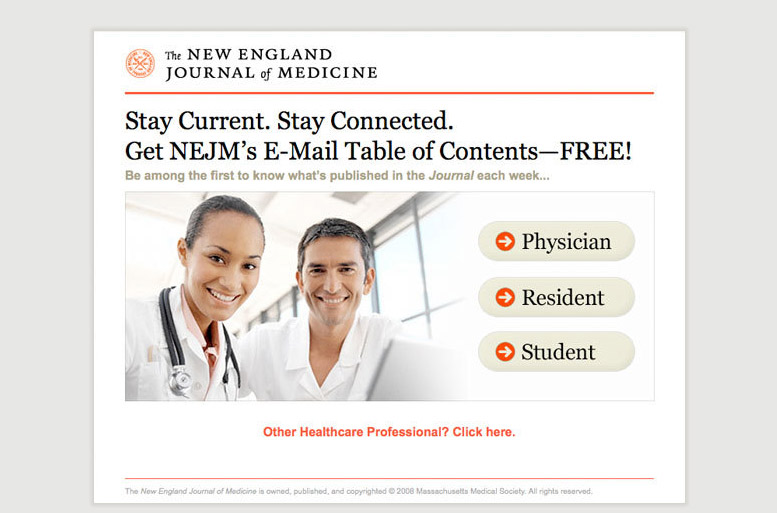Big buckets of value – finding the headline that works
 It’s tough writing headlines. Especially for key pages of a client’s site, such as the home page and landing pages. How often do you find yourself with five to ten ideas that are scrapped in search of the one perfect headline?
It’s tough writing headlines. Especially for key pages of a client’s site, such as the home page and landing pages. How often do you find yourself with five to ten ideas that are scrapped in search of the one perfect headline?
I often find myself in the same situation. To help remove the doubt and uncertainty, I came up with a framework that helps make choosing the perfect headline (almost) painless.
The Anatomy of a Headline
First we should establish what a headline should do for your audience. I believe it needs to have 3 things to make it work.
1. It needs to resonate with a pain point
2. It should speak to solving that pain point
3. It needs to be easy to understand
This week I am writing headlines for my client RoomKey PMS, a Hotel Software company. I am going to use them as an example of how to apply the framework to finding the most effective headline.
The product allows hotel staff to check guests in & out and has a lot of reporting to find out which segment of guests are the most profitable. It’s fast and easy to use with great customer support. It’s also a cloud-based solution so no need to worry about hardware or back ups.
Now we have a whole mix of features and benefits and as writer you often feel like you need to pick a single perfect headline. But you are more than writers. You are marketers and as a marketer you can help your clients in knowing your words are effective at driving action.
Big Buckets of Value Propositions
My goal is to work out which value proposition is best suited for each of my key pages. As the home page usually has the most SEO equity and acts as an entry page for a wider range of key phrases, it needs to have a wider value proposition.
For a feature page you can be more specific as you have a clearer understanding to the intent of the audience when reading that page.
I break down what the company does into buckets, or groups, that I believe their audience will care about. For the home page I see the following value propositions come through from the product and discovery sessions with the client:
- Helps You Make More Money
- Easy to Use with Great Support
- Fast and Secure
- Saves You Money [cloud based]
I also like to look at the client’s testimonials page to see why other customers have chosen their product over the competitors. This is a gut-check step to make sure that I am not missing anything.
Once I have my buckets it’s on to writing the headlines. At this stage I am testing which bucket is going to resonate best with my audience. I am not testing multiple headlines from the same bucket.
Take a look at this post for tips on writing great headlines.
Testing Your USP Buckets
The key metric we are looking at in testing headlines is how sticky they are at commanding the audience’s attention. But how can you quantify that into a web metric?
The data points I look at are Click Through Rate, Bounce Rate & Conversions. The first two are indicators of success, with conversions being the ultimate measure of performance.
1. Paid Search
This is my favorite method of testing my value buckets. It’s fast, cost effective and provides traffic to test conversion potential of your keywords.
First I create an AdGroup based on a number of core keywords. I write the Ads with the same body copy but create a unique headline based on each of my value buckets. The headline is the only thing different in the ad text.
When the ads are running you will start to see one version get more clicks with a higher Click Through Rate than it’s counter parts.
You can make sure the test is statistically valid with a tool like: http://www.vertster.com/adwords-tool/.
2. LinkedIn Ads
Linkedin allows me to target an audience based on job title and geography. I like to back up my assumptions by running a small campaign to make sure the value proposition I am selecting can command their attention.
With Linkedin ads, my headline needs to stand out from the page and overcome banner blindness to motivate them to click. This is different from Search PPC as the user is not actively looking for a solution. As it’s limited by job title, I know exactly who I am speaking to.
The Chief Financial Officer will respond well to Saving Money but the Chief Marketing Officer wants product growth.
Here we can begin to tailor the headlines based on audience needs defined by their job function. Linkedin typically takes longer to get valid results than PPC as clicks are slower – especially if the total audience you are targeting is smaller.
I have used this in the past to self-segment the audience right off of the home page to allow my copy to better address their specific needs.
3. A/B Testing
If you don’t have a budget for media (Adwords or Linkedin) you can run tests directly on your home page or landing pages. You will need some technical support, and depending on traffic volume, it can take longer to get a valid result.
Google Analytics offers A/B testing in the form of content experiments. With minimal code changes you can run your tests to see which headlines keep your visitors on task.
Which Bucket is Most Effective?
Using the outline above, I now have user feedback on which bucket is the most appealing to the audience. Within the data, I am looking at each of the following steps in the conversion flow:
- Click Through Rate – How effective is the headline at getting the click?
- Bounce Rate – Are prospects leaving right away?
- Conversion – Did they complete the task we want them to?
Click through rate tells us how well the value bucket is at grabbing the users attention. If it motivates them to click they must be interested in what we have to say. This is the easiest way to gauge how well the value proposition works.
Bounce rate tells us if the landing page is compelling enough to keep the user around. Bounce Rate is a leading indicator but not a success metric in itself.
Of course everyone loves conversions. It’s important to measure this and use it as a weighted factor in determining which Value Bucket to use.
The Value Bucket that has the best CTR with the lowest Bounce Rate and Highest Conversions is your winner!
Keep in mind our end objective right now is to establish which Value Bucket is the most important to the audience: e.g., is Cheap & Easy more important that Fast & Secure?
Next Steps
Once you have established which Value Bucket your audience is most interested in, there are numerous ways you can use it.
- Home Page Headlines
- Direct Mail
- Email Subject Lines
- SEO Page Titles
There is so much more work to be done to really fine tune conversions – but I will save that for a future post!
In the meantime, I welcome your comments and questions!
 About the Author ~ Graeme McLaughlin
About the Author ~ Graeme McLaughlin
A search marketer of 9 years Graeme has lead digital marketing strategy for American Red Cross, Zurich Financial, AAA and CIGNA Healthcare. He specializes in audience definition and conversion optimization, driving traffic from SEO, PPC and Social Media. He founded Optamo in 2010 to help businesses attract their audience and build engagement within it. He speaks at Search Marketing Conferences, loves ice hockey [Go Canucks] and landing page optimization. Follow him on Twitter @GraemeMac & @Optamo, and connect with him on Google+.
photo thanks to christopher.woo (Christopher Woo)
Turn your freelance copywriting business around by year’s end – and save 70%! SuccessWorks SEO Copywriting is holding a flash sale on the Copywriting Business Bootcamp, offering those who are quick to act a $700 savings! Be nimble – as the offer is good only up to the 30th applicant. Reserve your spot now!




Great post Graeme. Thanks for putting the steps together for creating and testing headlines.
If there are any questions on the post I am happy to answer them in the comments. Ask away.